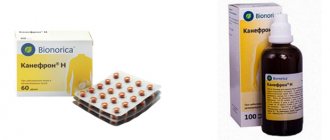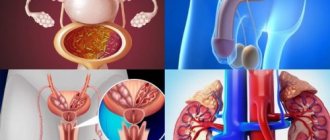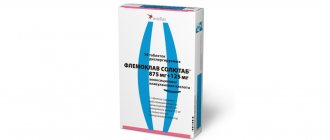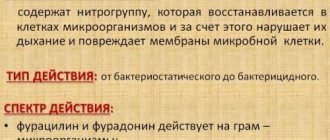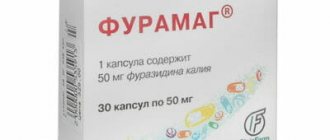Furagin-SZ tablet 50 mg x30
Furagin-SZ tablet 50 ml x30 North Star, ATX code: J01XE03 (Furazidin) Active substance: furazidin BP British Pharmacopoeia
Dosage form
FURAGIN-SZ
tab. 50 mg: 10, 30, 50, 60, 90, 100 or 120 pcs.reg. No.: LSR-003894/07 dated 11/19/07 - Indefinitely
Release form, composition and packaging
Tablets from greenish-yellow to yellow with an orange tint, flat-cylindrical in shape with a bevel.
1 tab.
furazidin 50 mg
Excipients: lactose monohydrate (milk sugar) - 18.8 mg, sucrose (sugar) - 18 mg, potato starch - 11.2 mg, stearic acid - 1 mg, polysorbate (Tween-80) - 1 mg.
Clinical and pharmacological group: Antibacterial drug, nitrofuran derivative. Uroantiseptic Pharmacotherapeutic group: Antimicrobial agent, nitrofuran The scientific information provided is general and cannot be used to make a decision about the possibility of using a specific drug.
pharmachologic effect
A broad-spectrum antimicrobial agent belonging to the nitrofuran group. Under the influence of nitrofurans, the respiratory chain and the tricarboxylic acid cycle (Krebs cycle) are suppressed, as well as other biochemical processes of microorganisms are suppressed, resulting in the destruction of their shell or cytoplasmic membrane.
Active against gram-positive cocci: Streptococcus spp., Staphylococcus spp., gram-negative rods: Escherichia coli, Salmonella spp., Shigella spp., Proteus spp., Klebsiella spp., Enterobacter spp., protozoa: Lamblia intestinalis and other microorganisms resistant to antibiotics.
Furazidin is more active against Staphylococcus spp., Escherichia coli, Aerobacter aerogenes, Bacterium citrovorum, Proteus mirabilis, Proteus morganii, compared to other nitrofurans.
For most bacteria, the bacteriostatic concentration ranges from 1:100,000 to 1:200,000. The bactericidal concentration is approximately 2 times higher.
As a result of the action of nitrofurans, microorganisms produce fewer toxins, and therefore an improvement in the patient’s general condition is possible even before a pronounced suppression of the growth of microflora. Nitrofurans activate the body's immune system: they increase the complement titer and the ability of leukocytes to phagocytose microorganisms. Furazidine in therapeutic doses stimulates leukopoiesis.
Resistance to furazidine develops slowly and does not reach a high degree.
Pharmacokinetics
After oral administration, furazidine is absorbed from the small intestine by passive diffusion. Absorption of nitrofurans from the distal segment of the small intestine exceeds absorption from the proximal and medial segments by 2 and 4 times, respectively (should be taken into account during the simultaneous treatment of urogenital infections and gastrointestinal diseases, in particular chronic enteritis). Nitrofurans are poorly absorbed from the colon.
Cmax in blood plasma lasts from 3 to 7 or 8 hours; furazidine is detected in urine after 3-4 hours.
Furazidin is distributed evenly in the body. The high content of the drug in the lymph is clinically important (it delays the spread of infection through the lymphatic tract). In bile its concentration is several times higher than in serum, and in cerebrospinal fluid it is several times lower than in serum. In saliva, the content of furazidin is 30% of its concentration in serum. The concentration of furazidin in the blood and tissues is relatively small, which is associated with its rapid release, while the concentration in the urine is much higher than in the blood.
Metabolized to a small extent (<.10%).
Excreted by the kidneys by glomerular filtration and tubular secretion (85%), partially undergoes reverse reabsorption in the tubules. At low concentrations of furazidin in the urine, the process of filtration and secretion predominates; at high concentrations, secretion decreases and reabsorption increases. Furazidine, being a weak acid, does not dissociate in acidic urine and undergoes intense reabsorption, which can enhance the development of systemic side effects. With an alkaline reaction of urine, the excretion of furazidine increases.
As the excretory function of the kidneys decreases, the metabolic rate increases.
Indications
For oral administration: urogenital infections (acute cystitis, urethritis, pyelonephritis), gynecological infections, skin and soft tissue infections, severe infected burns, for prophylactic purposes during urological operations (including cystoscopy, catheterization).
For external and local use: infectious and inflammatory diseases of the oral cavity and pharynx, infected wounds.
ICD-10 codes
Dosage regimen
Take orally after meals. Adults - 50-100 mg 3 times/day, children over 3 years old - 25-50 mg (no more than 5 mg/kg body weight) 3 times/day. The course of treatment is 7-10 days. If it is necessary to repeat the course of treatment, you should take a break for 10-15 days. To prevent infection (including during urological operations, cystoscopy, catheterization) - 50 mg once 30 minutes before the procedure.
Apply externally 2-3 times a day to wash wounds or wet dressings.
Apply topically 2-3 times a day in the form of rinses in the mouth and pharynx.
Side effect
From the digestive system: rarely - nausea, vomiting, loss of appetite, liver dysfunction.
From the central nervous system and peripheral nervous system: rarely - headache, dizziness, polyneuritis.
Allergic reactions: rarely - skin rash (including papular rashes).
Contraindications for use
Severe chronic renal failure, pregnancy, lactation (breastfeeding), children under 4 years of age, hypersensitivity to furazidine and other nitrofurans.
Use during pregnancy and breastfeeding The use of the drug during pregnancy and lactation (breastfeeding) is contraindicated.
Use for impaired renal function Contraindicated in severe chronic renal failure.
Use in children
Contraindicated in children under 3 years of age.
special instructions
To reduce the likelihood of side effects, take furazidine with plenty of liquid.
If side effects occur, use should be discontinued (toxic effects are more likely to occur in patients with reduced renal excretory function).
During the treatment period, the patient is advised to refrain from drinking alcohol, as side effects may increase.
Do not take double the dose to make up for a missed dose.
Use with caution in cases of glucose-6-phosphate dehydrogenase deficiency.
Drug interactions
When combining furazidine with ristomycin, chloramphenicol, sulfonamides, the risk of hematopoietic suppression increases (should not be used simultaneously).
It is not recommended to use drugs that can acidify urine (including ascorbic acid, calcium chloride) simultaneously with nitrofurans.
Furagin
Trade name: Furagin tablets 0.05 g International name: Furazidin
Release forms: tablets 50 mg (polyethylene jars, dark glass jars, cell-free contour packages, cell contour packages, polystyrene bottles, polyethylene bottles)
Composition: furazidin 50 mg
Pharmacological group: antimicrobial agent, nitrofuran
Pharmacological group according to ATK: J01XE (Nitrofuran derivatives)
Pharmacological action: nitrofuran, antimicrobial,
Indications: Infectious and inflammatory diseases: purulent wounds, cystitis, urethritis, pyelonephritis, purulent arthritis, infections of the female genital organs, conjunctivitis, keratitis, burns, prevention of infections during urological operations, cystoscopy, catheterization. For washing cavities: peritonitis, pleural empyema.
Dosage regimen: Orally, after meals - 0.05-0.1 g 3 times a day for 7-14 days. If necessary, after a 10-15 day break, treatment courses are repeated. Locally, during treatment, a 1% solution prepared with a 0.9% NaCl solution is used for douching and rinsing. In ophthalmology, an aqueous solution is used in a dilution of 1:13000: 2 drops are instilled into the affected eye, 4-6 times a day.
Contraindications: Hypersensitivity, severe chronic renal failure, children (up to 1 year), pregnancy, lactation.
Side effects: Decreased appetite, nausea, vomiting, headache, dizziness, polyneuritis, liver dysfunction, allergic reactions (skin rash, including papular rash). Overdose. Symptoms: neurotoxic reactions, polyneuritis, liver dysfunction, acute toxic hepatitis. Treatment: drug withdrawal, taking large amounts of fluid, symptomatic therapy, antihistamines, B vitamins. There is no specific antidote.
Pharmacodynamics: Antimicrobial agent, nitrofuran derivative. Effective against gram-positive cocci (Staphylococcus spp., Streptococcus spp.), gram-negative bacilli (E. coli, Salmonella spp., Shigella spp., Klebsiella spp.). Plasmodium aeruginosa, Enterococcus spp., Acinetobacter spp., most strains of Proteus spp., Serratia spp. are resistant. The mechanism of action is associated with inhibition of nucleic acid synthesis. Depending on the concentration, it has a bactericidal or bacteriostatic effect. Against most bacteria, the bacteriostatic concentration ranges from 10-20 μg/ml. The bactericidal concentration is approximately 2 times higher. Under the influence of nitrofurans in microorganisms, the activity of the respiratory chain and the tricarboxylic acid cycle (Krebs cycle) is suppressed, as well as other biochemical processes are inhibited, which leads to the destruction of their shell or cytoplasmic membrane. As a result of the action of nitrofurans, microorganisms produce fewer toxins, and therefore an improvement in the general condition of the patient is possible even before a pronounced suppression of the growth of microflora. Nitrofurans, unlike many other antimicrobial drugs, not only do not suppress the body’s immune system, but, on the contrary, activate it (increase the complement titer and the ability of leukocytes to phagocytose microorganisms).
Pharmacokinetics: Absorption - in the small intestine, by passive diffusion. Metabolized in the liver. 6% is excreted by the kidneys; the average concentration of furazidine in urine exceeds its bacteriostatic concentration.
Special instructions: To prepare a 0.5 and 1% solution, 0.5 g or 1 g of the drug is respectively dissolved in 100 ml of hot water for injection. The solution is immediately filtered, poured into neutral glass bottles and sterilized with running steam at 100 degrees C for 30-45 minutes or at 110 degrees C for 15-20 minutes. To prevent side effects, plenty of fluids, B vitamins and antihistamines are prescribed. Carefully. Chronic renal failure, glucose-6-phosphate dehydrogenase deficiency, liver and nervous system diseases, neonatal period (up to 1 month) - for local use.
Drug registration number: 72/270/32
Furagin tablet 50 mg pack cont cell(3)/pack of cards x30
Trade name: Furagin tablets 0.05 g International name: Furazidin
Release forms: tablets 50 mg (polyethylene jars, dark glass jars, cell-free contour packages, cell contour packages, polystyrene bottles, polyethylene bottles)
Composition: furazidin 50 mg
Pharmacological group: antimicrobial agent, nitrofuran
Pharmacological group according to ATK: J01XE (Nitrofuran derivatives)
Pharmacological action: nitrofuran, antimicrobial,
Indications: Infectious and inflammatory diseases: purulent wounds, cystitis, urethritis, pyelonephritis, purulent arthritis, infections of the female genital organs, conjunctivitis, keratitis, burns, prevention of infections during urological operations, cystoscopy, catheterization. For washing cavities: peritonitis, pleural empyema.
Dosage regimen: Orally, after meals - 0.05-0.1 g 3 times a day for 7-14 days. If necessary, after a 10-15 day break, treatment courses are repeated. Locally, during treatment, a 1% solution prepared with a 0.9% NaCl solution is used for douching and rinsing. In ophthalmology, an aqueous solution is used in a dilution of 1:13000: 2 drops are instilled into the affected eye, 4-6 times a day.
Contraindications: Hypersensitivity, severe chronic renal failure, children (up to 1 year), pregnancy, lactation.
Side effects: Decreased appetite, nausea, vomiting, headache, dizziness, polyneuritis, liver dysfunction, allergic reactions (skin rash, including papular rash). Overdose. Symptoms: neurotoxic reactions, polyneuritis, liver dysfunction, acute toxic hepatitis. Treatment: drug withdrawal, taking large amounts of fluid, symptomatic therapy, antihistamines, B vitamins. There is no specific antidote.
Pharmacodynamics: Antimicrobial agent, nitrofuran derivative. Effective against gram-positive cocci (Staphylococcus spp., Streptococcus spp.), gram-negative bacilli (E. coli, Salmonella spp., Shigella spp., Klebsiella spp.). Plasmodium aeruginosa, Enterococcus spp., Acinetobacter spp., most strains of Proteus spp., Serratia spp. are resistant. The mechanism of action is associated with inhibition of nucleic acid synthesis. Depending on the concentration, it has a bactericidal or bacteriostatic effect. Against most bacteria, the bacteriostatic concentration ranges from 10-20 μg/ml. The bactericidal concentration is approximately 2 times higher. Under the influence of nitrofurans in microorganisms, the activity of the respiratory chain and the tricarboxylic acid cycle (Krebs cycle) is suppressed, as well as other biochemical processes are inhibited, which leads to the destruction of their shell or cytoplasmic membrane. As a result of the action of nitrofurans, microorganisms produce fewer toxins, and therefore an improvement in the general condition of the patient is possible even before a pronounced suppression of the growth of microflora. Nitrofurans, unlike many other antimicrobial drugs, not only do not suppress the body’s immune system, but, on the contrary, activate it (increase the complement titer and the ability of leukocytes to phagocytose microorganisms).
Pharmacokinetics: Absorption - in the small intestine, by passive diffusion. Metabolized in the liver. 6% is excreted by the kidneys; the average concentration of furazidine in urine exceeds its bacteriostatic concentration.
Special instructions: To prepare a 0.5 and 1% solution, 0.5 g or 1 g of the drug is respectively dissolved in 100 ml of hot water for injection. The solution is immediately filtered, poured into neutral glass bottles and sterilized with running steam at 100 degrees C for 30-45 minutes or at 110 degrees C for 15-20 minutes. To prevent side effects, plenty of fluids, B vitamins and antihistamines are prescribed. Carefully. Chronic renal failure, glucose-6-phosphate dehydrogenase deficiency, liver and nervous system diseases, neonatal period (up to 1 month) - for local use.
Drug registration number: 72/270/32
Furagin-SZ
Furagin-SZ tablet 50 ml x30 North Star, ATX code: J01XE03 (Furazidin) Active substance: furazidin BP British Pharmacopoeia
Dosage form
FURAGIN-SZ
tab. 50 mg: 10, 30, 50, 60, 90, 100 or 120 pcs.reg. No.: LSR-003894/07 dated 11/19/07 - Indefinitely
Release form, composition and packaging
Tablets from greenish-yellow to yellow with an orange tint, flat-cylindrical in shape with a bevel.
1 tab.
furazidin 50 mg
Excipients: lactose monohydrate (milk sugar) - 18.8 mg, sucrose (sugar) - 18 mg, potato starch - 11.2 mg, stearic acid - 1 mg, polysorbate (Tween-80) - 1 mg.
Clinical and pharmacological group: Antibacterial drug, nitrofuran derivative. Uroantiseptic Pharmacotherapeutic group: Antimicrobial agent, nitrofuran The scientific information provided is general and cannot be used to make a decision about the possibility of using a specific drug.
pharmachologic effect
A broad-spectrum antimicrobial agent belonging to the nitrofuran group. Under the influence of nitrofurans, the respiratory chain and the tricarboxylic acid cycle (Krebs cycle) are suppressed, as well as other biochemical processes of microorganisms are suppressed, resulting in the destruction of their shell or cytoplasmic membrane.
Active against gram-positive cocci: Streptococcus spp., Staphylococcus spp., gram-negative rods: Escherichia coli, Salmonella spp., Shigella spp., Proteus spp., Klebsiella spp., Enterobacter spp., protozoa: Lamblia intestinalis and other microorganisms resistant to antibiotics.
Furazidin is more active against Staphylococcus spp., Escherichia coli, Aerobacter aerogenes, Bacterium citrovorum, Proteus mirabilis, Proteus morganii, compared to other nitrofurans.
For most bacteria, the bacteriostatic concentration ranges from 1:100,000 to 1:200,000. The bactericidal concentration is approximately 2 times higher.
As a result of the action of nitrofurans, microorganisms produce fewer toxins, and therefore an improvement in the patient’s general condition is possible even before a pronounced suppression of the growth of microflora. Nitrofurans activate the body's immune system: they increase the complement titer and the ability of leukocytes to phagocytose microorganisms. Furazidine in therapeutic doses stimulates leukopoiesis.
Resistance to furazidine develops slowly and does not reach a high degree.
Pharmacokinetics
After oral administration, furazidine is absorbed from the small intestine by passive diffusion. Absorption of nitrofurans from the distal segment of the small intestine exceeds absorption from the proximal and medial segments by 2 and 4 times, respectively (should be taken into account during the simultaneous treatment of urogenital infections and gastrointestinal diseases, in particular chronic enteritis). Nitrofurans are poorly absorbed from the colon.
Cmax in blood plasma lasts from 3 to 7 or 8 hours; furazidine is detected in urine after 3-4 hours.
Furazidin is distributed evenly in the body. The high content of the drug in the lymph is clinically important (it delays the spread of infection through the lymphatic tract). In bile its concentration is several times higher than in serum, and in cerebrospinal fluid it is several times lower than in serum. In saliva, the content of furazidin is 30% of its concentration in serum. The concentration of furazidin in the blood and tissues is relatively small, which is associated with its rapid release, while the concentration in the urine is much higher than in the blood.
Metabolized to a small extent (<.10%).
Excreted by the kidneys by glomerular filtration and tubular secretion (85%), partially undergoes reverse reabsorption in the tubules. At low concentrations of furazidin in the urine, the process of filtration and secretion predominates; at high concentrations, secretion decreases and reabsorption increases. Furazidine, being a weak acid, does not dissociate in acidic urine and undergoes intense reabsorption, which can enhance the development of systemic side effects. With an alkaline reaction of urine, the excretion of furazidine increases.
As the excretory function of the kidneys decreases, the metabolic rate increases.
Indications
For oral administration: urogenital infections (acute cystitis, urethritis, pyelonephritis), gynecological infections, skin and soft tissue infections, severe infected burns, for prophylactic purposes during urological operations (including cystoscopy, catheterization).
For external and local use: infectious and inflammatory diseases of the oral cavity and pharynx, infected wounds.
ICD-10 codes
Dosage regimen
Take orally after meals. Adults - 50-100 mg 3 times/day, children over 3 years old - 25-50 mg (no more than 5 mg/kg body weight) 3 times/day. The course of treatment is 7-10 days. If it is necessary to repeat the course of treatment, you should take a break for 10-15 days. To prevent infection (including during urological operations, cystoscopy, catheterization) - 50 mg once 30 minutes before the procedure.
Apply externally 2-3 times a day to wash wounds or wet dressings.
Apply topically 2-3 times a day in the form of rinses in the mouth and pharynx.
Side effect
From the digestive system: rarely - nausea, vomiting, loss of appetite, liver dysfunction.
From the central nervous system and peripheral nervous system: rarely - headache, dizziness, polyneuritis.
Allergic reactions: rarely - skin rash (including papular rashes).
Contraindications for use
Severe chronic renal failure, pregnancy, lactation (breastfeeding), children under 4 years of age, hypersensitivity to furazidine and other nitrofurans.
Use during pregnancy and breastfeeding The use of the drug during pregnancy and lactation (breastfeeding) is contraindicated.
Use for impaired renal function Contraindicated in severe chronic renal failure.
Use in children
Contraindicated in children under 3 years of age.
special instructions
To reduce the likelihood of side effects, take furazidine with plenty of liquid.
If side effects occur, use should be discontinued (toxic effects are more likely to occur in patients with reduced renal excretory function).
During the treatment period, the patient is advised to refrain from drinking alcohol, as side effects may increase.
Do not take double the dose to make up for a missed dose.
Use with caution in cases of glucose-6-phosphate dehydrogenase deficiency.
Drug interactions
When combining furazidine with ristomycin, chloramphenicol, sulfonamides, the risk of hematopoietic suppression increases (should not be used simultaneously).
It is not recommended to use drugs that can acidify urine (including ascorbic acid, calcium chloride) simultaneously with nitrofurans.
